Background :
Consecutive image frames of video sequences change gradually. In vision based object tracking there are two main approaches that exploit this redundancy. One of them uses the assumption that the object does not move much from frame to frame and employs a local search around the previous object position to locate the object on the next frame. Algorithms in this group tend to be very precise when locked on the object but may have problems if the environment is highly cluttered (they may lose track of the object). The other approach makes use of some filtering algorithm (e.g. Kalman Filter), or particle filtering methods e.g the CONDENSATION algorithm (also called as N-IPS in the signal processing literature). The particle filters keep multiple hypothesis about the object state and this increases its robustness against clutter. However, particle filters often give very crude position information unless an excessively large number of particles is used.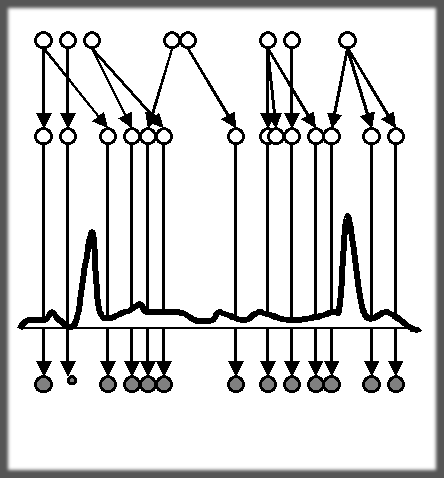 N-IPS, suffers from inefficiency problems if the observation density
is uninformative and/or uniformly very small except
in a small neighborhood of the true state since then particles
which are not in this small vicinity of the ``true'' state will
all have roughly equal observation likelihoods and the filter becomes
effectively decoupled from the observations.
N-IPS, suffers from inefficiency problems if the observation density
is uninformative and/or uniformly very small except
in a small neighborhood of the true state since then particles
which are not in this small vicinity of the ``true'' state will
all have roughly equal observation likelihoods and the filter becomes
effectively decoupled from the observations.
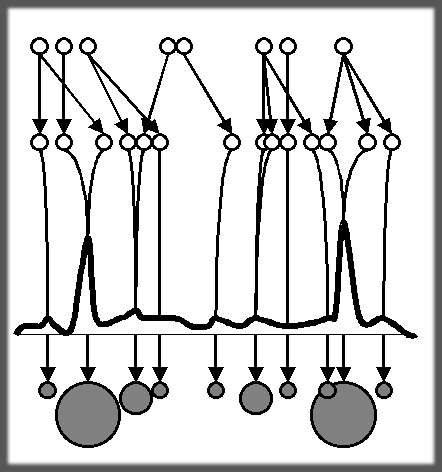 LS-N-IPS was designed to overcome the problem of N-IPS with peaky observation densities, therefore it is natural to consider it in visual tracking problems. LS-N-IPS combines local search with particle filtering and thus can be thought of as a combination of the two main streams of vision based tracking research mentioned above. As a consequence, the algorithm inherits the high precision of local search based object tracking methods and the robustness of the particle filter based methods, even when a small number of particles is used.
LS-N-IPS was designed to overcome the problem of N-IPS with peaky observation densities, therefore it is natural to consider it in visual tracking problems. LS-N-IPS combines local search with particle filtering and thus can be thought of as a combination of the two main streams of vision based tracking research mentioned above. As a consequence, the algorithm inherits the high precision of local search based object tracking methods and the robustness of the particle filter based methods, even when a small number of particles is used.
.
Results
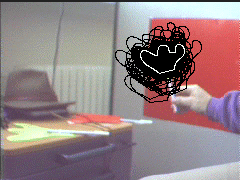 Here is an MPEG (0.7Mb) showing the
LS-N-IPS algorithm tracking an object,
in a cluttered room. Tracking is real time. Only 100 particles were used.
Here is an MPEG (0.7Mb) showing the
LS-N-IPS algorithm tracking an object,
in a cluttered room. Tracking is real time. Only 100 particles were used.
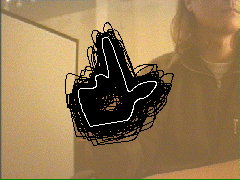 Here is an MPEG (0.5Mb) showing the LS-N-IPS algorithm tracking a hand in real-time,
in a dark room with 100 particles.
Here is an MPEG (0.5Mb) showing the LS-N-IPS algorithm tracking a hand in real-time,
in a dark room with 100 particles.
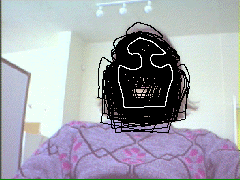 Here is an MPEG (0.7Mb) showing the LS-N-IPS algorithm tracking a face,
in a dark room with 100 particles. Real time performance.
Here is an MPEG (0.7Mb) showing the LS-N-IPS algorithm tracking a face,
in a dark room with 100 particles. Real time performance.
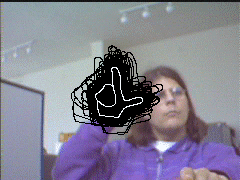 This MPEG (0.9Mb) shows tracking a hand moving in front of the face,
in a cluttered room with only 50 particles. 73 frames can be processed per second on a P4, 1.4GHz Pentium. The Local Search is done by an artificial neural network trained in advance.
This MPEG (0.9Mb) shows tracking a hand moving in front of the face,
in a cluttered room with only 50 particles. 73 frames can be processed per second on a P4, 1.4GHz Pentium. The Local Search is done by an artificial neural network trained in advance.
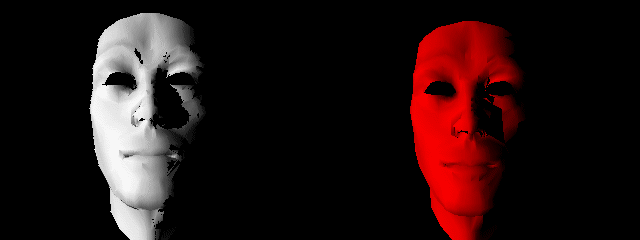 This MPEG (5.8Mb) shows tracking a facial mask moving in 3D. The Local Search here is a local pose from shading algorithm. The left of the image is the original video, while the right hand side is the tracking result.
This MPEG (5.8Mb) shows tracking a facial mask moving in 3D. The Local Search here is a local pose from shading algorithm. The left of the image is the original video, while the right hand side is the tracking result.
Publications
- LS-N-IPS: An Improvement of Particle Filters by means of Local Search
-
Peter Torma and Csaba Szepesvári
Non-linear Control Systems (NOLCOS2001), 2001.
- Efficient Object Tracking in Video Sequences by means of LS-N-IPS
-
Peter Torma and Csaba Szepesvári
In Proc. Second International Symposium on Image and Signal Processing and Analysis (ISAP'01), pp. 277-282, 2001.
- Towards Facial Pose Tracking
-
Peter Torma and Csaba Szepesvári
In Proc. First Hungarian Computer Graphics and Geometry Conference Budapest, Hungary, pp. 10-16, 2002
Page maintained by tyus@mindmaker.hu.
Last updated 1st July, 2002